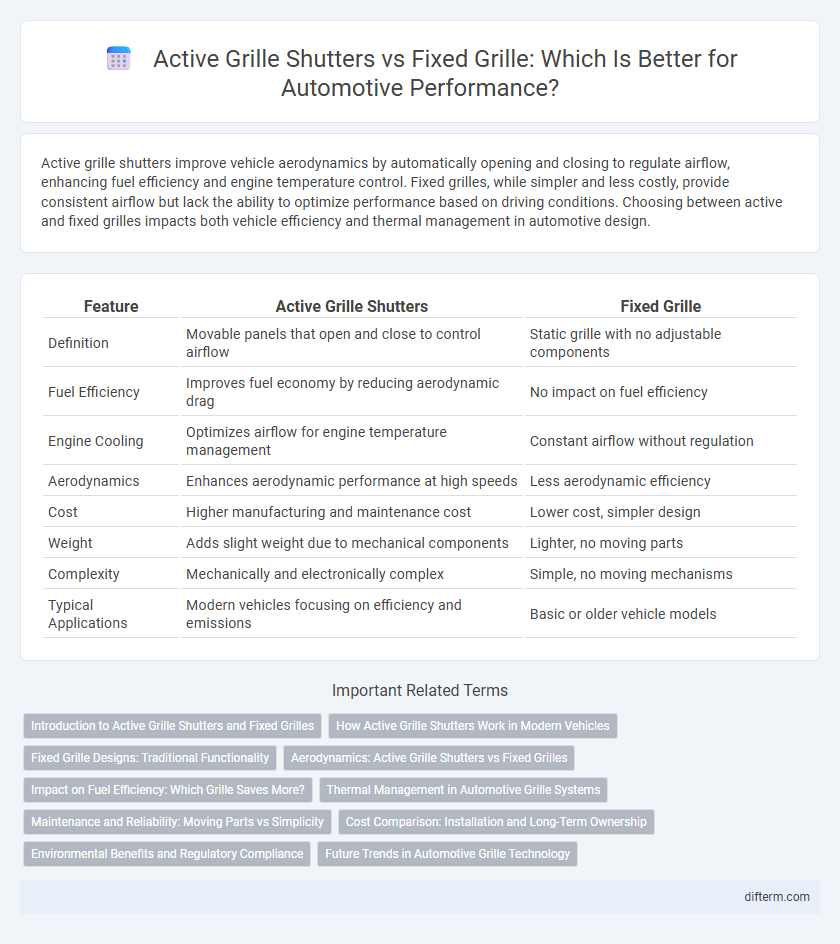Active grille shutters improve vehicle aerodynamics by automatically opening and closing to regulate airflow, enhancing fuel efficiency and engine temperature control. Fixed grilles, while simpler and less costly, provide consistent airflow but lack the ability to optimize performance based on driving conditions. Choosing between active and fixed grilles impacts both vehicle efficiency and thermal management in automotive design.
Table of Comparison
| Feature | Active Grille Shutters | Fixed Grille |
|---|---|---|
| Definition | Movable panels that open and close to control airflow | Static grille with no adjustable components |
| Fuel Efficiency | Improves fuel economy by reducing aerodynamic drag | No impact on fuel efficiency |
| Engine Cooling | Optimizes airflow for engine temperature management | Constant airflow without regulation |
| Aerodynamics | Enhances aerodynamic performance at high speeds | Less aerodynamic efficiency |
| Cost | Higher manufacturing and maintenance cost | Lower cost, simpler design |
| Weight | Adds slight weight due to mechanical components | Lighter, no moving parts |
| Complexity | Mechanically and electronically complex | Simple, no moving mechanisms |
| Typical Applications | Modern vehicles focusing on efficiency and emissions | Basic or older vehicle models |
Introduction to Active Grille Shutters and Fixed Grilles
Active grille shutters dynamically adjust airflow through the front grille to optimize engine cooling and improve aerodynamic efficiency, significantly enhancing fuel economy and reducing emissions. Fixed grilles, by contrast, provide a constant opening that allows uninterrupted airflow but may create additional drag, negatively impacting vehicle performance. Integrating active grille shutters in automotive design offers a smarter balance between cooling needs and aerodynamic improvements compared to traditional fixed grille setups.
How Active Grille Shutters Work in Modern Vehicles
Active grille shutters in modern vehicles automatically adjust airflow by opening and closing slats within the grille to optimize engine temperature and improve aerodynamic efficiency. Controlled by vehicle sensors and the engine management system, these shutters close at higher speeds to reduce drag and open when cooling is needed, such as during engine warm-up or heavy load conditions. This technology enhances fuel efficiency, reduces emissions, and supports thermal management without compromising engine performance.
Fixed Grille Designs: Traditional Functionality
Fixed grille designs in automotive applications serve as a traditional component focused primarily on engine cooling by allowing consistent airflow to the radiator. Unlike active grille shutters, fixed grilles lack dynamic control, resulting in constant aerodynamic drag but simpler construction and lower maintenance requirements. These grilles maintain durability and provide a classic vehicle aesthetic while ensuring essential ventilation under various driving conditions.
Aerodynamics: Active Grille Shutters vs Fixed Grilles
Active grille shutters enhance vehicle aerodynamics by automatically opening or closing to regulate airflow, reducing drag and improving fuel efficiency. Fixed grilles provide constant air intake regardless of driving conditions, often leading to higher drag and lower aerodynamic performance. The dynamic adjustment of active shutters enables optimized airflow management, crucial for maintaining optimal engine temperature and minimizing aerodynamic resistance.
Impact on Fuel Efficiency: Which Grille Saves More?
Active grille shutters dynamically close at higher speeds to reduce aerodynamic drag, leading to significant improvements in fuel efficiency compared to fixed grilles. Fixed grilles provide constant airflow regardless of conditions, which increases drag and decreases fuel economy. Studies show vehicles with active grille shutters can achieve fuel savings of up to 5% under optimal driving conditions.
Thermal Management in Automotive Grille Systems
Active grille shutters dynamically adjust airflow through the front grille to optimize engine temperature, reducing aerodynamic drag and improving fuel efficiency. Fixed grilles provide constant airflow, which can lead to suboptimal thermal regulation and increased aerodynamic resistance. Advanced thermal management in automotive grille systems leverages active shutters to balance engine cooling needs with aerodynamic performance, enhancing overall vehicle efficiency.
Maintenance and Reliability: Moving Parts vs Simplicity
Active grille shutters enhance vehicle aerodynamics by automatically opening and closing, but their moving components require regular maintenance to ensure optimal functionality. Fixed grilles offer greater reliability due to their simplicity and lack of mechanical parts, reducing the risk of failure and lowering long-term maintenance costs. Choosing between the two involves balancing the performance benefits of active shutters against the durability and ease of upkeep associated with fixed grilles.
Cost Comparison: Installation and Long-Term Ownership
Active grille shutters typically have a higher initial installation cost than fixed grilles due to their integrated electronic components and control systems. Over the long term, active grille shutters can reduce fuel consumption by improving aerodynamic efficiency, potentially lowering vehicle operating costs. Fixed grilles, while cheaper upfront and simpler to maintain, do not offer the same fuel-saving benefits, which may result in higher overall ownership expenses over time.
Environmental Benefits and Regulatory Compliance
Active grille shutters enhance vehicle aerodynamics by automatically adjusting airflow to reduce drag, significantly improving fuel efficiency and lowering CO2 emissions compared to fixed grilles. These systems contribute to compliance with stringent environmental regulations such as Euro 6d and Corporate Average Fuel Economy (CAFE) standards by optimizing thermal management and reducing greenhouse gas output. Automakers leverage active grille shutters to meet climate targets and improve overall vehicle sustainability without compromising engine cooling performance.
Future Trends in Automotive Grille Technology
Active grille shutters enhance aerodynamic efficiency by dynamically adjusting airflow to reduce drag, improving fuel economy and lowering emissions compared to fixed grilles. Future trends emphasize integration with advanced sensors and AI for real-time thermal management, optimizing engine cooling and battery performance in electric and hybrid vehicles. Innovations in lightweight materials and smart controls will drive the evolution of adaptive grille systems, supporting sustainability goals and enhancing vehicle performance.
active grille shutters vs fixed grille Infographic

 difterm.com
difterm.com